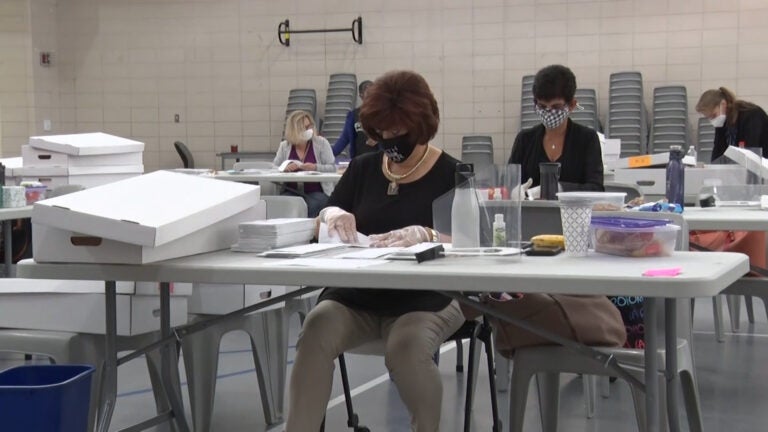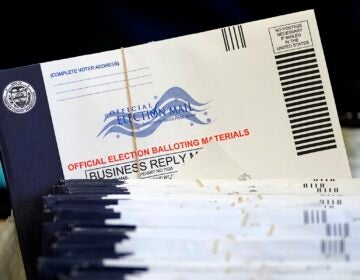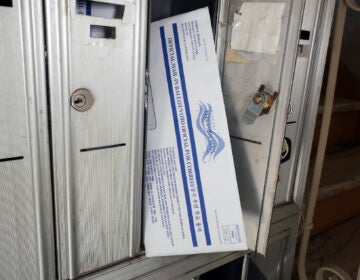For the first time, NJ officials to get an early start on counting ballots
It took more than a month after the July primary for the state to certify results, and that was with fewer than 1.5 million voting.

Election workers in Union County sorted mail-in ballots on the day of primary elections, July 7, 2020. (NJ Spotlight)
This article originally appeared on NJ Spotlight.
—
While thousands of mail-in ballots continue to flood into county elections offices, New Jersey officials Saturday will begin counting general election votes.
But while counties can start counting ballots early for the first time ever, due to a law Gov. Phil Murphy signed in late August, they cannot get any running tallies or reveal any count results. If they do, they risk criminal prosecution.
Murphy and the Democratic-controlled Legislature included the provision allowing the counting of ballots to begin as many as 10 days before the close of polls because of the expected flood of paper ballots that take longer to count than voting machine tallies and the need to get results processed more quickly due to federal deadlines.
It took more than a month after the July primary for the state to certify results, and that was with fewer than 1.5 million voting. As of Thursday, counties had already received about 2.16 million ballots, which represents about 55% of those who voted in the 2016 presidential election, Murphy said. The law requires counties to certify their election results by Nov. 20.
New Jersey counties run elections, and each one does it a little differently, but this is how several county officials said they are handling the ballots. In many cases, they are working in large, open indoor spaces with temporary staff to handle a daily flood of ballots that far exceeds any volume they’ve had to handle before.
“We’re getting thousands in every day that need to be processed,” said Evelynn Caterson, chair of the Atlantic County Board of Elections. She likened the work to an automobile assembly line. “The first group does this to the car and the next group does that to the car and then the next group does something else to the car. That’s about how we’re flowing.”
Through now, and as ballots continue to come in, the first thing officials do is scan them into the state database to log that the ballot has been received. This prevents anyone from casting two ballots and allows a voter to use the state’s Track My Ballot tool. Because of what the site is calling “historically high volume,” it could take one to two weeks for a ballot to be logged into the system, depending on the number of people doing this work in a given county and the number of ballots that county is receiving. Once it is logged, a ballot will only be marked as “received,” as opposed to “accepted” or “rejected,” until the count is certified, likely Nov. 20, according to the state website.
Election boards must address questionable votes
Officials remove the inner envelope from the outer one and check that signatures match. If there is a question over the validity of the information or signature on an envelope, it is set aside for the board of elections to consider. Because of the new law, boards are required to meet four times a week through this election process to deal with questionable votes. The voter of any ballot that the board decides to question is being sent within 24 hours of that decision a “cure” form that the voter needs to complete and return attesting that he did submit the ballot.
The next step is to “process” ballots before they start counting. This involves first removing the certificate from the outside of the envelope — for those concerned about the privacy of their vote, this is the point at which the ballot and envelope are separated so there is no way to know later how an individual voted because the voter does not sign the ballot itself. Then the ballots are removed from the inner envelopes, flattened out in groups, then stored in a secure room until it’s time to start scanning.
“The more we have prepped before we start running, the smoother the process goes,” said Union County Board of Elections Administrator Nicole DiRado. She said a ballot scanning machine can count 300 ballots a minute. “Nobody’s opening and prepping 300 ballots a minute. The more we have ready before it goes through the machine, the quicker that process will go.”
Starting Saturday, counties can begin running ballots through scanning machines, which read and record the colored circles and translate them into votes. Ballots that have been incorrectly filled out — a person voted for too many candidates for an office, for instance — get kicked out and are set aside for hand counting. The machines keep running tallies in memory that are not readily available to workers, officials said. Many said they are not going to request any count until 8 p.m. on Nov. 3. The new law makes disclosing any individual’s vote or any ballot counts before polls close a third-degree offense. These are punishable by up to five years in prison and a fine of up to $15,000.
To be fully transparent, several counties are planning to allow the public to watch the counting process, either via closed circuit screens at county offices or — in the case of Bergen County — from home via an online livestream.
Most counties are expected to begin reporting results on election night after the polls close, but final tallies won’t be available for more than two weeks. Some officials expect to begin processing provisional ballots after Election Day but cannot start counting them until Nov. 10 — the last day that a mail-in ballot received via postal delivery can be tallied — to ensure a person who voted in person had not previously mailed in a ballot.

Get daily updates from WHYY News!
WHYY is your source for fact-based, in-depth journalism and information. As a nonprofit organization, we rely on financial support from readers like you. Please give today.






